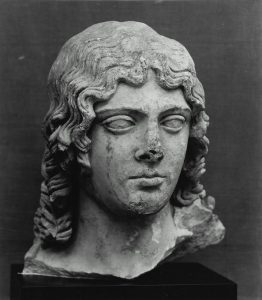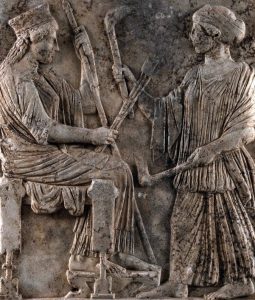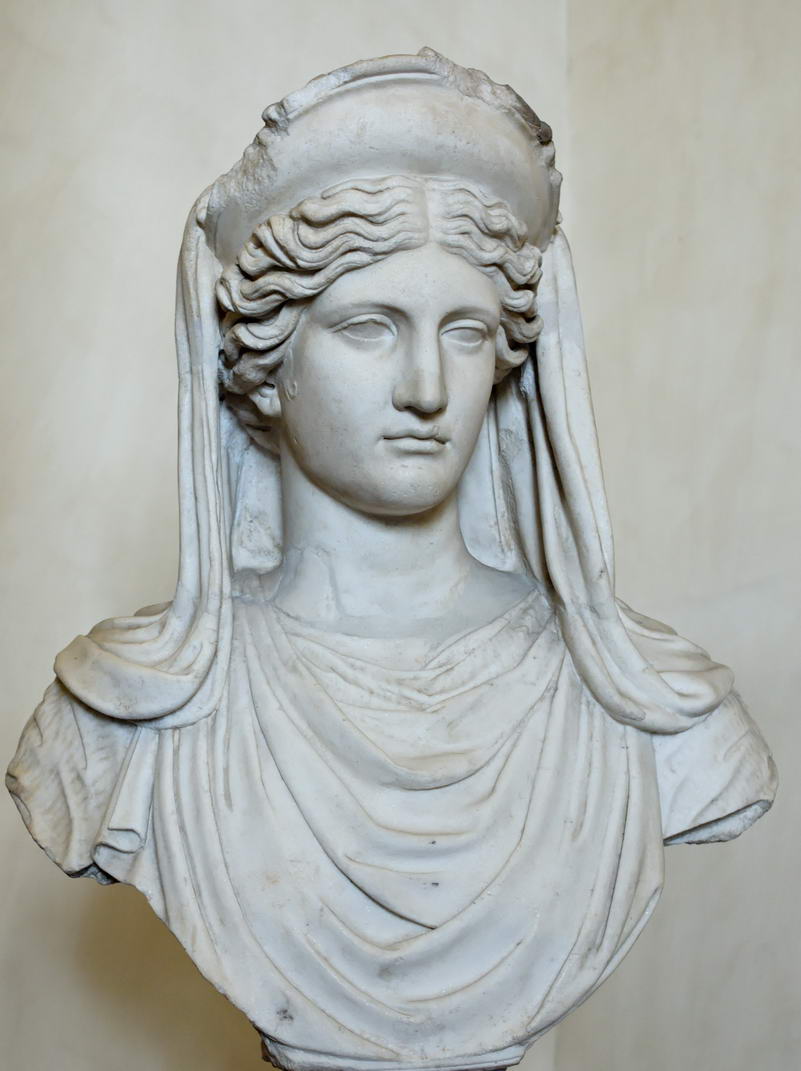Demeter (Ceres)
Demeter, who was the daughter of Cronus and Rhea, was the goddess of cereal grains, earth and fertility of the World. Her name indicates that she is a mother. The best sources for the principal myth of Demeter are the “Second Homeric Hymn,” and the fifth book of Ovid’s “Metamorphoses,” where, naturally, the names of the main protagonists are changed to their Roman counterparts: Ceres, Pluto, and Proserpine.
Demeter and Persephone
Demeter’s daughter Persephone, whom Homer refers to as having beautiful hair, was abducted by Hades the god of the underworld while picking flowers in the

meadow. Demeter scoured the globe for her daughter, whom she bore from Zeus, and was unable to find her anyware. When she was about to abandon hope, Helios the god of Sun told her the whereabouts of her daughter. So Demeter went to Zeus and asked for his help to rescue her daughter. Hades refused to give her daughter back, so Demeter left Olympus bitter and twisted, disguised as a mortal old woman and began to roam various cities.
The Institution of the Eleusinian Mysteries
When she arrived at a town named Eleusis, she stopped by the house of King Celeus and offered to the wife of the king. Metaneira, that she would nurse her son. The queen accepted to the offer and gave his son Demophon to Demeter to be raised her. Demeter loved the child and fed him with the food of gods and wished to immortalize him by holding him to fire. The behaviors of of this old woman, though, raised doubts in the mind of the queen, an one day she actually caught her while holding the child to fire. Tremendously petrified, the queen scolded Demeter. After this, Demeter had to explain to the queen that he was actually going to immortal if it weren’t for her, and she transformed into a goddess again. Later the king and queen erected a temple in Eleusis and decided it ot Demeter, thus trying to propitiate to her.
Because Demeter fell out with nature in the absence of her daughter, she ceased the fertility of the earth and a drough prevailed. Demeter appeared most commonly as a grain goddess. The name Ioulo (from ioulos, “grain sheaf”) has been regarded as identifying her with the sheaf and as proving that the cult of Demeter originated in the worship of the grain mother. In that wider sense Demeter was akin to Gaea (Earth), with whom she had several epithets in common, and was sometimes identified with the Great Mother of the Gods (Cybele, also identified with Rhea). Thereupon, Zeus had to reconcile Demeter and Hades, and

they agreed that the child would spend the half of the year with her mother and the rest with her husband in the land of the dead. Each time Persephone came out of the ground to be with her mother, the flowers blossomed, and the spring came. Her return to the underworld symbolized winter. The grain, just like Persephone, must die and be buried under the earth in order to bear much fruit above it.
Demeter’s Consorts: Iasion, Poseidon, and Zeus
Poseidon lost his heart to this blonde goddess, but Demeter refused his love. Still, reportedly, Poseidon disguised himself into various appearances and seduced Demeter. Poseidon disguised himself into various appearances and seduced Demeter. It is known that Zeus also fell in love with this beautiful goddess and had his daughter Persephone (Kore) by her. There is a beautiful sculpture of Persephone (Kore) from the 5th century BC, and many head statues of her at the Acropolis Museum in Athens. Demeter fell in love with Iasion (a Cretan), a mortal, and lay with in a thrice-ploughed field. She bore Plutus from this union. Plutus was the personification of wealth and fertility. When he declared that he was not going to give wealth to the immoral and graceless, Zeus blinded him and distributed his welath among the public.
In Greek Art
In her sculptures, Demeter is shown as a beautiful woman with languiid eyes and blonde hair flowing down on her shoulders. A wreath of wheat ears decorates her hair. A büst of Demeter, which was taken out of the sea by sponge hunters in Bodrum, can be seen at the İzmir Museum today. There is another sculpture of her at the same museum, decipting her together with Poseidon. Demeter holds a wheat ear in her right hand, and a burning torch in her left hand. She was sometimes shown with a wand or a sickle in her hand. Opium poppy was her sacred flower. She would also wear wreaths made of myrtle or narcissus. The magnificient sculpture of Demeter found in Knidos and dating to 340 BC can be seen

at the British Museum today. There is a temple dedicated to Demeter in Eleusis in Greece, to the West of Athens. Most of the Demeter temples in Greece were built on open field, outside the city walls. There were holy sites for Demeter in the antique cities of Pergamum and Priene. She was referred to as Ceres in Rome. There is another temple for Dmeter in the antique city of Akragas, which is located on the Island of Sicily. The group of sculptures illustrating the threesome of Kore, Demeter and Hebe, which was discovered at the acropolis of Athens and can be seen at the British Museum today, dates to 432 BC.
Cult
She was worshiped as such at Sparta, and especially at the festival of Chthonia at Hermione in Argolis, where a cow was sacrificed by four old women. The epithets Erinys (‘Avenger’) and Melaina (‘the Black One’) as applied to Demeter were localized in Arcadia and stress the darker side (divinity of the underworld ) of her character. The snake and the pig were sacred to her and the torch is often depicted in connection with Demeter because of her persistent search for Persephone.

